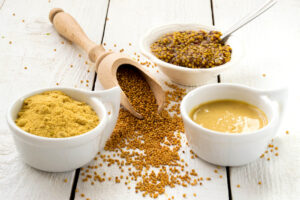Prepared mustard.
It’s in nearly every fridge or pantry in the modern world and used in, or on, thousands of dishes ranging from the classic and iconic, to today’s contemporary recipes.
The list is simply exhausting!
Salad dressings, sauces, deviled eggs, potato salad, beef, lamb, pork, seafood, and of course, on our beloved hot dogs.

Yet as ubiquitous as prepared mustard around the world, it’s a recipe rarely made in our homes, or, in professional kitchens?
Why is that?
Because it’s beyond simple to make.
Mustard surely gets enough love otherwise. In fact, there are numerous festivals all around the world extolling mustard’s culinary virtues.
From Napa Valley, California to Berlin, Germany, mustard festivals are held each year and feature famous dozens of contests.
Famous Chefs at these events offer demonstrations, and there are numerous opportunities to feast on fabulous dishes using mustard in every imaginable way.
How is prepared mustard made?

Let’s look at how a prepared mustard recipe is made. Maybe, along the way, you’ll discover that it’s something you’d really enjoy making in your kitchen.
“House” prepared mustard is a pretty impressive (and very simple) way to add a distinctive and artisanal flair to your menus.
The basic ingredients needed to make mustard can be as simple as mustard and a liquid. The method however, can done in one of 2 ways.
- Soak the whole seeds in the liquid, then blend or grind the mustard seeds into a paste. Or,
- Grind the seeds to the desired fineness BEFORE adding your liquids. The additional grinding afterwards isn’t necessary.
Chemistry in action.
There’s a lot of chemical stuff going on when you make mustard.
The “heat, or bite” that comes from prepared mustard is within the seeds, and then it reacts with the liquids. So, breaking the seeds open is a part of the process.
It’s already been done for you with powdered mustard but it’s something you must do if you’re also using whole seeds.
Spicy or mild?
Temperature “heat”, (even hot water) negates much of the chemical reaction that give you the “spicey heat” component in prepared mustards.
If you want a mustard with more of a “bite” you should use cold water.
Warm water also works, but gives you more of a “mild” mustard reaction and flavor.
Using water alone, generally only gives you a few days (or less) of great mustard flavor. This can, (and should) be “stabilized”, by adding an acid (such as vinegar, lemon juice or horseradish) and some salt.
It also gives you that traditional taste, that most people love and accept.
Which seeds?
Three seeds used to make mustards, they are: white, brown and black.
The white mustard plant, actually makes the mustard seeds that we call yellow, and they make a very pale-yellow powder, not the bright yellow you see in the bottle. They also make a rather mild mustard while, brown and black mustard, are a bit more “robust” in flavor.
The yellow “salad” mustard you see in your grocery store is typically made with the yellow seeds from the white mustard plant with turmeric spice added for color.
The ingredient statement on a bottle of Heinz mustard reads: DISTILLED WHITE VINEGAR, MUSTARD SEED, WATER, SALT, TURMERIC, NATURAL FLAVOR AND SPICES.
Brown mustard seeds are found in many premium prepared mustards including the popular Grey Poupon brand.
Black mustard seeds (called rai) are the most pungent and the least common seed to be found in American mustards but they are popular in Southern Indian cuisines.
Many people who enjoy making prepared mustards for their kitchen prefer to use at least 2 mustard seed varieties to create a more “complex” flavor.
A common combination is a hand or machine ground, brown seed, with a white (or yellow mustard powder added as a base).

Making your prepared mustard.
Since making a prepared mustard is rather easy, try making a batch using this recipe. We think you’ll agree that adding your own house-made mustard to your culinary repertoire might just plant the “seed” for many great recipe ideas.
We’ll use method number 2 with brown mustard seeds and yellow mustard powder.
Simple Prepared Mustard
Makes about 2 cups
½ cup brown mustard seeds
1 cup ground yellow mustard powder
1 tablespoon salt
2 tsp ground turmeric (optional)
2 tablespoons honey or brown sugar (optional)
1 cup cold water
¼ Cup + 1 tablespoon apple cider or white wine vinegar
- Grind the whole mustard seeds for a few seconds in a spice grinder, or by hand with a mortar and pestle. Leave the seeds only coarsely ground to give the final prepared mustard some whole seed identity.
- Add the ground seeds into a non-reactive (Stainless steel or glass) mixing bowl and add the salt and mustard powder. If you choose to add the turmeric and sweetener, add that as well.
- Pour in the water, then mix together well. When everything is incorporated, let this rest for at least 15 minutes, then add the vinegar.
- Pour into a glass or plastic container and store in the fridge.
- Your mustard will initially seem thin, but fear not, as the liquids are absorbed by the mustard, it will thicken up in a day’s time.
Perhaps the hardest part of this recipe is waiting for the mustard to fully mature, which takes at least 2 days.
You’ll be tempted to taste it right away, even the next day, but fair warning, you’ll likely be disappointed because it will taste a bit bitter as the vinegar will just be beginning its to do its transformational “mellowing”.
Having said that, if it’s your first go at it, give it a try right away, and then a few days later. You’ll definitely notice the difference!
Once you’ve made your first batch, you may want to make some tweaks to suit your own personal tastes, or to fit a particular menu item you’ve created.
Among the things you can “experiment with” are:
- Changing the mustard seeds to powder ratio.
- Using beer or white wine as all or part of the water
- Changing the sweetener
- Adding some “heat”…chopped chiles or horseradish.
- Adding chopped herbs (tarragon is a very popular option)
Your finished mustard, if stored properly under refrigeration, can last up to a year. Even longer if you process it as you would any canning technique.
Of course, you’ll want to use a great source for your mustard seeds which is why so many Chefs buy their mustard seeds from the Red Goose Spice Company.
If your goal is to eventually make larger batches of mustard, we sell our mustard seeds in any size quantity that suits your seed needs.Prepared

